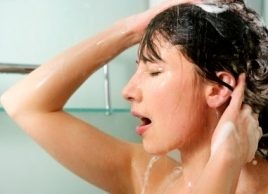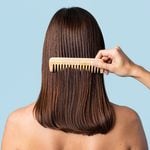How to get rid of dandruff
Battling flakes? Find out what causes dandruff and how to get rid of it with the best shampoos for your scalp

Source: Best Health Magazine, March/April 2009
Our skin is designed to silently and invisibly shed old skin cells and grow new ones. Dandruff, however, is a kink in this assembly-line process, causing old skin cells on the scalp to build up and clump into the unsightly flakes that land on your favourite black sweater. About half of the population suffers from a flaky scalp at some point in our lives.
Dandruff is actually a mild form of seborrheic dermatitis, a skin condition marked by large yellow scales, redness and inflammation of the scalp, or of other areas of the skin. While you might associate dandruff with a dry, flaking scalp, ‘it is actually caused by excess oiliness,’ explains Dr. Charlene Linzon, dermatologist, lecturer and director of the University of Toronto’s hair clinic.
The culprit here is a common yeast’called malassezia’that grows on everyone, and it feeds on oil from the scalp, Linzon says.
What tips the scale in dandruff’s favour depends on the individual: how much oil your scalp produces, and how vigorously the yeast grows. ‘The yeast breaks down scalp oil, leaving behind a by-product [unsaturated fatty acid] that causes the flaking associated with dandruff, and the irritation, inflammation and scaling that define seborrheic dermatitis,’ says Linzon. Dandruff is also more likely to develop at certain stages of life, such as in infancy (called cradle cap), and around puberty, when oil (sebum) secretion increases’providing more food for yeast. Stress also increases oil production.
Thankfully, you can get this problem under control with over-the-counter (OTC) products. Start by shampooing your scalp frequently with a medicated shampoo to reduce oiliness. (Note: Health Canada recommends that dandruff products, even OTC, should never be used on children under two without consulting a doctor.) Here are your choices:
1. Antifungals
Examples: Head & Shoulders Classic, Selsun Blue, Nizoral
How they work: The active ingredients in these are zinc pyrithione (Head & Shoulders Classic), selenium sulphide (Selsun Blue) and ketoconazole (Nizoral). They slow down the growth of the yeast that causes the flaking and scaling.
Need to know: Choose a zinc pyrithione product first because it is mild and aesthetically acceptable, suggests Debra Sibbald, a professor at the University of Toronto’s Leslie Dan faculty of pharmacy; reserve products with selenium sulphide or ketoconazole for tougher dandruff. Don’t use selenium sulphide or zinc pyrithione within 48 hours of colouring or perming hair; selenium sulphide may increase hair breakage, and zinc pyrithione may interfere with metal-deposit hair colourants. Don’t leave selenium sulphide on your hair, scalp or skin for long periods (e.g., overnight) because it can cause irritation.
2. Coal tar
Examples: Neutrogena T/Gel Therapeutic Shampoo, Polytar, Denorex
How they work: Coal tar, the active ingredient in these products, slows skin cell turnover, and also works as an anti-inflammatory, says Linzon.
Need to know: It may stain hair (especially blond or grey hair) and skin, and it can increase skin photosensitivity.
3. Salicylic acid
Examples: Sebulex, Sebcur
How they work: Salicylic acid boasts a keratolytic agent, which helps to loosen and dislodge scales, explains Linzon.
Need to know: It can dry the scalp too much, causing more flaking.
Use products properly
How you use dandruff products can affect how well they fight flakes. Dr. Charlene Linzon, a dermatologist, offers these tips:
‘ Switch products regularly, alternating between two or three kinds. For example, you could use, say, Nizoral one day and Head & Shoulders the next; or alternate every second or third time you shampoo.
‘ Leave shampoo on long enough to do its job‘five to 10 minutes, or, for a more intensive treatment, 20 to 30 minutes (once every couple of weeks).
‘ Use more frequently. Labels usually suggest using a shampoo twice weekly, but daily use is helpful for some. (Just watch for hair breakage and dryness’a sign you’re overdoing it.)
‘ A two-step process is more effective in fighting dandruff, so rather than using ‘2-in-1’ products, shampoo first and follow with a conditioner. Apply conditioner only to hair ends to avoid developing a greasier scalp.
When to get Rx help
Give over-the-counter remedies about a month to show effectiveness, says pharmacist Debra Sibbald’that’s how long it takes for skin-cell turnover. If an OTC doesn’t make you flake-free, see your family doctor or dermatologist about a prescription-strength treatment such as steroids (e.g., hydrocortisone) or ciclopirox 1.5% (e.g., Stieprox). Use only as recommended.
This article was originally titled "Fighting Flakes," in the March/April 2009 issue of Best Health. Subscribe to Best Health today and never miss an issue!




